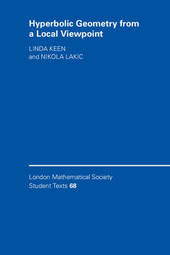
|
Hyperbolic Geometry from a Local Viewpoint
Paperback / softback
Main Details
| Title |
Hyperbolic Geometry from a Local Viewpoint
|
| Authors and Contributors |
By (author) Linda Keen
|
|
By (author) Nikola Lakic
|
| Series | London Mathematical Society Student Texts |
|---|
| Physical Properties |
| Format:Paperback / softback | | Pages:282 | | Dimensions(mm): Height 229,Width 152 |
|
| Category/Genre | Geometry |
|---|
| ISBN/Barcode |
9780521682244
|
| Classifications | Dewey:516.9 |
|---|
| Audience | | Professional & Vocational | |
|---|
| Illustrations |
Worked examples or Exercises; 5 Halftones, unspecified; 27 Line drawings, unspecified
|
|
Publishing Details |
| Publisher |
Cambridge University Press
|
| Imprint |
Cambridge University Press
|
| Publication Date |
8 March 2007 |
| Publication Country |
United Kingdom
|
Description
Written for graduate students, this book presents topics in 2-dimensional hyperbolic geometry. The authors begin with rigid motions in the plane which are used as motivation for a full development of hyperbolic geometry in the unit disk. The approach is to define metrics from an infinitesimal point of view; first the density is defined and then the metric via integration. The study of hyperbolic geometry in arbitrary domains requires the concepts of surfaces and covering spaces as well as uniformization and Fuchsian groups. These ideas are developed in the context of what is used later. The authors then provide a detailed discussion of hyperbolic geometry for arbitrary plane domains. New material on hyperbolic and hyperbolic-like metrics is presented. These are generalizations of the Kobayashi and Caratheodory metrics for plane domains. The book concludes with applications to holomorphic dynamics including new results and accessible open problems.
Author Biography
Linda Keen is a Professor of Mathematics at the City University of New York, Lehman College and the Graduate Center. Nikola Lakic is an Associate Professor of Mathematics at the City University of New York, Lehman College and the Graduate Center.
Reviews'Here new and interesting results are collected and presented for a target audience of graduate students and researchers, but the first half of the book is well accessible also for undergraduate students, and indeed everyone who is interested in an introduction to hyperbolic geometry.' Internationale Mathematische Nachrichten
|